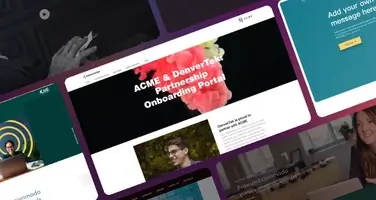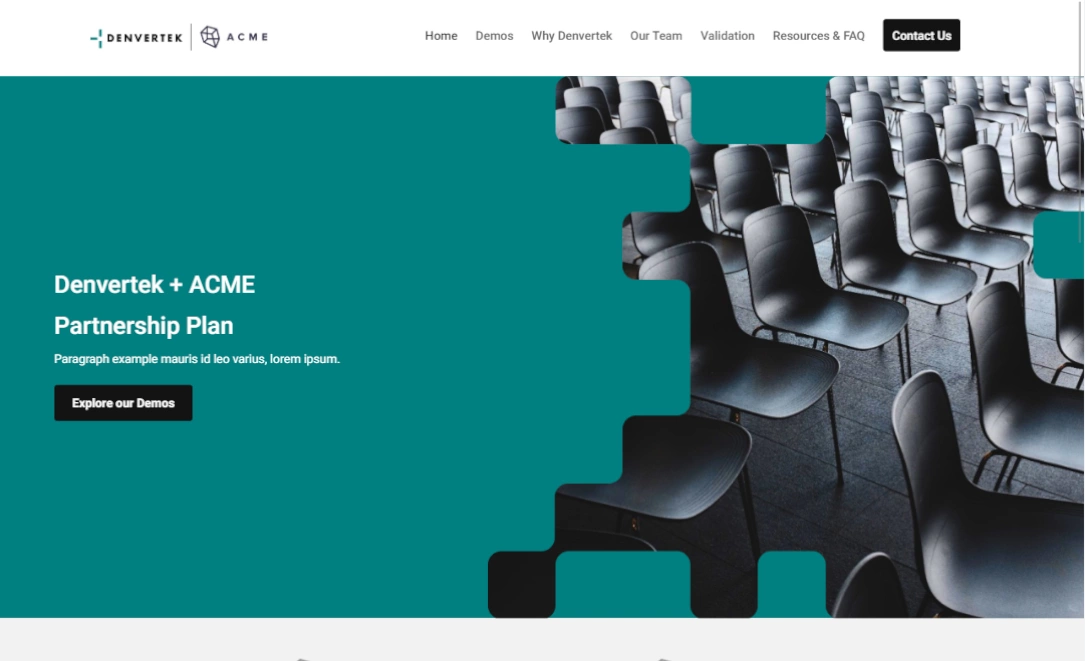The ability to share valuable information in easily accessible ways was once a bragging right. Now, it’s an expectation across industries. Outdated enterprise communication isn’t going to cut it, and businesses are looking for new ways to interact with their consumers.
It’s likely you already have an information-rich website that has been carefully curated with information and landing pages that are helpful for a general audience. However, if you’re looking to target a niche audience, offer web-based access to certain clients, or create highly interactive experiences for short-term initiatives, you might consider creating a microsite.
So, what are microsites? The simplest definition of a microsite is that it is a micro website. In other words, microsites are miniature websites (or single web pages) that offer simple, malleable solutions to many complex communication needs. In this article, we’ll cover what a microsite is, the benefits of using one, and how to get the most out of your microsite.
What is a microsite really?
A microsite is a branded content site outside of your main website, serving as a specialized extension of your existing web presence. It’s a platform that hosts content that would be valuable to certain audiences, rather than a business’s general audience.
A microsite is typically on its own subdomain or unique URL. It can be an individual web page or a small collection of pages. Microsites are packed with content all their own, providing a highly curated experience. They’re perfect for digital marketing campaigns, business proposal showcases, or onboarding tools for new employees.
Instead of having others parse through your website, you can share your microsite with the parties it’s most relevant to. This is especially helpful if you strive to elevate your web presence, create highly accessible deliverables, or analyze specific data regarding your targeted content.
A microsite is more than a website—it’s a content experience
A microsite is not a website. Your company’s website is reserved for all the basic, general information about your business and brand. A microsite is a unique web destination to tailor the content on one topic with a distinct purpose, what we at Zoomforth call a content experience.
Because of their specialized content, microsites are flexible spaces that you can use to address a range of organizational needs including:
- Create sites for events, newsletters, sales proposals, and employee learning portals.
- Design rich, highly interactive user experiences.
- Promote or announce brand partnerships and sponsorships.
The possibilities of a microsite are limitless. Designating a microsite for a certain purpose keeps your main website from getting cluttered with temporary content and your web presence organized and targeted.
The benefits of a microsite for your brand
Microsites allow you to push the boundaries of your web presence. Microsites can help you address short-term goals, like promoting a new product or service, but that’s not all! They can also help you work towards various long-term goals: customer engagement, SEO performance, and brand visibility.
More than 50% of readers spend less than 15 seconds on a webpage after accessing it. Such a low rate of engagement calls for strategic campaigns that are immediately useful to consumers. Microsites allow you to focus your content and design on specific needs, interests, and goals. Because of how specialized they are, they hone in on what the user needs, making engagement more successful.
Because all of the content is independent of your website, visitors can quickly access the information they need. Also, the content is specific to them, meaning you can reduce your bounce rates. Packing the microsite with keywords makes microsites a great SEO tool if you’re hosting it on your own domain. If you’re having the microsite company you’re using host it, you’ll be provided with array of performance analytics.
Reduce the risk of experimentation
Tailored content gives you access to the granular site and user data, meaning marketing strategies involve less guesswork and more analytics. You’ll know where, when, and how much consumers engaged with your content.
Microsites also allow you to strategize new approaches to campaigns that don’t work. Microsites can be as permanent or temporary as you need them to be, meaning experimentation is doable with little risk. No more overhauling your website for one purpose and finding it doesn’t work—use a microsite instead!
Microsite development 101: How to make the best microsites?
Creating a microsite is easy. Anyone can do it. However, if you want your microsites to be impactful, then you need to know how to create a microsite. You need to understand how to use content on microsites, what kind of microsite design to focus on, how many and which interactive elements to use, and even how to track your microsite data. Here are some quick tips.
Content-rich pages
Your microsite is the place for users to dive deep into one distinct topic, and content is key. Once you’ve determined what the purpose of your microsite is—marketing, experiential, informative—you can start to collect all the important details that your user is seeking and craft content to answer those questions.
Your microsite is your opportunity to connect users to information-rich material that moves them to action. Keep it specific to a designated topic, goal, or action. You can keep content rich by including:
- Testimonials
- Case studies
- Initiative backgrounds
- Research
Intuitive design
Effective microsites keep users highly engaged with content from the get-go. Making the microsite as user-friendly as possible is an important part of creating an engaging user experience.
You can keep the design user-friendly by checking that your microsites include these elements:
- Keep design consistent across different content and layouts
- Make hyperlinks visible by changing their color or underlining them
- Create accessibility elements such as video transcription and voice-to-text options
Interactive elements
You have the option to create highly interactive and immersive user experiences that may not be appropriate for your traditional website. This might include games, polls, and interactive maps.
Brands use interactive elements to keep users engaged and excited to immerse themselves in product features and marketing campaigns.
Here are some examples of microsites that capitalize on interactive features to create immersive experiences:
Interactive experiences can make consumers feel connected to products. Recent marketing research conducted by Accenture finds that is the case for as many as 47% of users.
Performance analytics
Gathering data and conducting meaningful analysis about created content can be as difficult as creating content in itself. General site data can tell you some things, but not everything about how effective your engagement strategies are.
Because microsites reach out to specific markets, the data they generate is highly specific. You can determine which strategies were most effective with granular information about different user experiences.
Design your very own microsite with Zoomforth
Now that you know how to build a microsite, you’re ready to create your own effective and user-friendly microsites. The next step is to figure out the platform that you’ll be working on. The service should be comprehensive to use, easy to update and provide valuable analytics.
At Zoomforth, we know that creating an interactive user experience that capitalizes on a range of web features shouldn’t be complicated. Without the need for a formally-trained developer, you can design and publish your microsites with ease.
Zoomforth offers many features to create your microsites, including:
- An intuitive, drag-and-drop design interface
- Style presets and custom brand styling
- A media library with unlimited storage
- Automated mobile layouts
- Comprehensive, real-time analytics
- Real-time in-app support and help center
Many enterprises, including three of the Big Four accounting firms, have used Zoomforth to elevate their business. If you’re interested in taking advantage of microsites’ many uses and benefits, request a demo with Zoomforth to start creating interactive user experiences that last.



